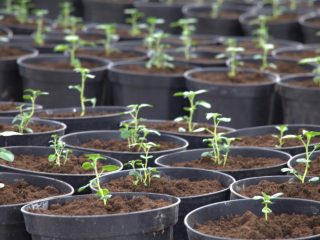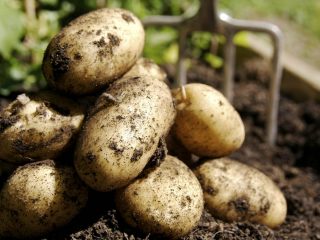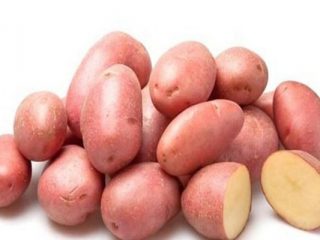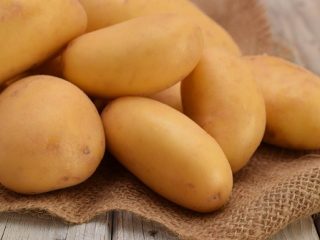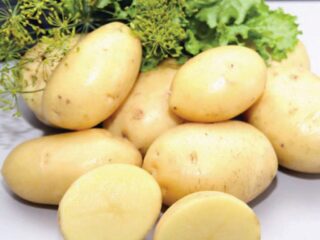Content
Breeders are constantly working to create improved varieties of vegetables, increasing their characteristics and taste. As an example, we can take an improved hybrid based on the Sineglazka variety - Lugovskoy potato. It is characterized by increased productivity and good shelf life.
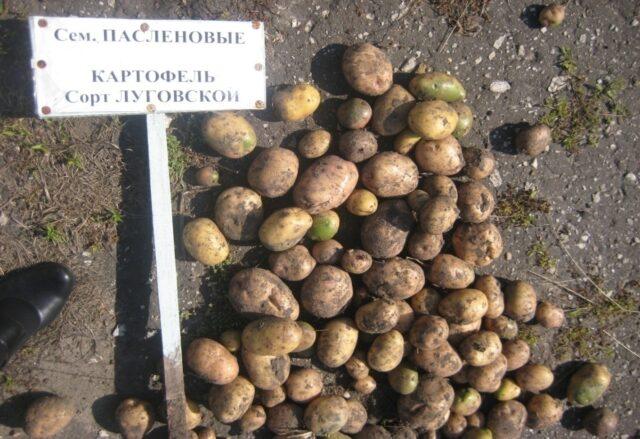
Due to its high yield, Lugovskoy potatoes are suitable for growing on an industrial scale
History of origin
The Lugovskaya variety is the brainchild of Ukrainian breeders, which was bred at the Institute of Seed Potato Growing at the Academy of Agrarian Sciences in the Lugansk region. The prototype of the hybrid was the Sineglazka potato, but, unlike its progenitor, Lugovskoy has a number of advantages, such as earlier ripening, cold resistance and increased shelf life.
Lugovskoy potatoes were included in the State Register of the USSR in 1987.Preferred for cultivation in temperate climate areas. It grows well in the territory from the Northwestern to the Far Eastern regions.
Description of potato variety Lugovskoy
Externally, a garden plant does not have any specific features. Lugovskoy potatoes are valued more for their excellent taste. It is also worth noting its ease of care and high resistance to common diseases.
Bush
The potato bush of the Lugovskoy variety is medium-sized, compact, and erect. The leaves are small, dark green, slightly pubescent, with well-drawn veins.
During flowering, large corollas with white or beige flowers form at the tops of the bush. They do not last long, after which they dry out and fall off; in rare cases, berries are formed in their place.
The root system is powerful, well developed, allowing the formation of up to 15 medium-sized tubers.
Tubers
Lugovskaya potatoes look attractive, which affects the commercial qualities of the variety. The tubers of the hybrid are medium-sized, their size varies from 80 to 120 g, sometimes there are specimens weighing up to 200 g. The shape of the root crops is round. The skin is thin, smooth, light pink with a few superficial eyes.
When cut, the tubers are white and do not darken. During heat treatment, potatoes are moderately crumbly, which depends on the amount of starch, which under different growing conditions can vary from 12 to 19%.
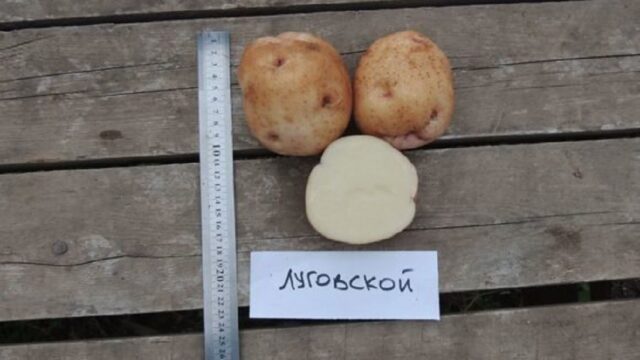
The keeping quality of potatoes of the Lugovskoy variety is up to 97%
Characteristics of Lugovskoy potatoes
As can be seen from the description and photo of the Lugovskaya potato variety, the hybrid has a lot of advantages, so it is successfully cultivated both by gardeners on personal plots and by farmers on large farms. Characterized by good taste and ease of cultivation.
Taste qualities of Lugovskoy potatoes
Meadow potatoes belong to table varieties, culinary type C. Since root vegetables are characterized by well-cooked, soft, moderately mealy pulp, they are used for preparing various dishes (boiling, frying, pureeing, baking). The taste qualities are rated as high.
Ripening time for Lugovskoy potatoes
Potatoes of the Lugovskoy variety are classified as mid-early, since from the moment of planting until the ripening of the root crops, an average of 70 to 85 days pass. When harvested early (up to 75 days after germination), the skin of the tubers remains thin.
Potato yield Lugovskoy
The productivity is noted to be high, so with proper care, up to 15 medium-sized tubers can be collected from one bush (up to approximately 350 kg per hundred square meters). The maximum harvest rate per hectare was recorded at 514 centners.
You can clearly see the yield of potatoes of the Lugovskoy variety in the video review:
Growing regions
The Lugovskoy variety, unlike its predecessor, is more cold-resistant. It adapts perfectly to various climatic conditions, therefore it is suitable for cultivation in the Northern, Northwestern, Central, Central Black Earth, North Caucasus, Ural, West Siberian and Far Eastern regions.
Disease resistance
The hybrid was bred taking into account increased resistance to common potato diseases.It is practically not susceptible to cancer, blackleg and scab. It has good immunity to fungal diseases and, due to its early ripening period, is not afraid of late blight. But when the soil is waterlogged, it can be affected by Fusarium or Alternaria.
Advantages and disadvantages
Any garden plant has a number of advantages and disadvantages, this also applies to Lugovskaya potatoes. Breeders tried to take into account all the negative qualities of root crops, trying to eliminate them when breeding a hybrid.
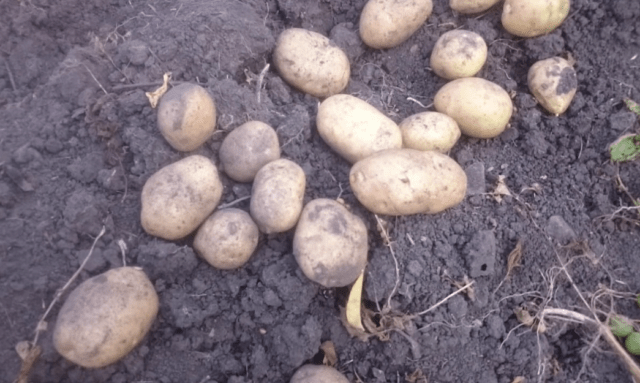
Most Lugovskoy potato tubers have a neat shape without significant flaws
Pros:
- cold resistance;
- mid-early ripening;
- high yield;
- attractive presentation of root crops;
- high taste qualities;
- rich composition of microelements and vitamins;
- good shelf life up to 97%;
- stable immunity;
- ease of care.
Minuses:
- sensitivity to soil nutrition (in depleted soil, the level of starch in root crops is significantly reduced);
- If there is an excess of moisture, the potatoes will rot.
Landing rules
Potatoes are planted in mid- or late May, depending on the region. The main condition is heated soil to +9 ºC.
Lugovskaya seed potatoes are selected without obvious signs of rotting or other defects. The presence of sprouts on the tubers is mandatory. Before planting, it is advisable to treat the seed material with fungicides.
The soil needs to be prepared in the fall; to do this, it is dug up along with humus or compost. In the spring, repeated digging is carried out and mineral fertilizers are added to the soil.
The landing pattern is standard.The distance between the holes should be at least 30 cm, and the row spacing should be about 50-70 cm. This is necessary for further hilling of the bushes.
The hole should be made to a depth of up to 15 cm. In regions with a warm climate, you can not deepen the tubers too much; 10 cm will be enough.
Care instructions
Potatoes require minimal care. It consists of watering, fertilizing, weeding and hilling.
During the growing season, watering should be carried out no more than three times. During planting, during the period of active growth and before the end of flowering.
If the soil is nutritious, then you can limit yourself to only fertilizing the soil in the fall when preparing the site for winter. If the soil is depleted, humus or wood ash is added to the hole during planting. This fertilizing is sufficient to obtain a good harvest.
Weeding and hilling are carried out throughout the entire growing season. These steps begin as soon as the sprouts reach at least 10 cm, then repeat after rain and watering.
Removing weeds is necessary for better soil aeration. Hilling is important for Lugovskaya potatoes due to the close formation of tubers to the surface of the earth, this way you can minimize exposure to sunlight on them.
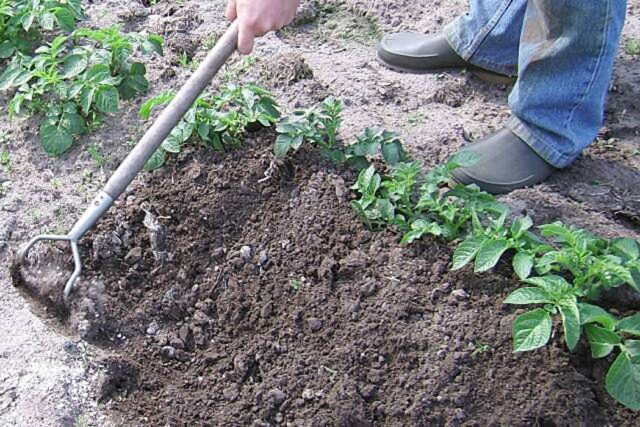
During the growing season, hilling is carried out at least three times
Harvest and storage
Lugovskoy potatoes are harvested after the tops begin to wither and turn yellow. If necessary, root crops are dug up 75-80 days after planting. In approximately 5-7 days, the tops are mowed so that the tubers become stronger.
You can start digging up tubers in mid-summer, but full harvesting is done between late August and mid-September. The weather should be dry. Late harvest of potatoes threatens the loss of their taste and the formation of hard skin.
After digging up the tubers, they need to be given time to dry. To do this, they are scattered in one layer on the ground for 2-3 hours, after which they are sorted. Potatoes for consumption are distributed into bags and sent to a cool, dark place with good ventilation. Tubers that are selected for planting next year are placed in boxes and also placed in a dark room.
Conclusion
Lugovskoy potatoes are an unpretentious vegetable crop that has a sufficient number of advantages compared to other varieties. That is why more and more gardeners prefer this hybrid. Today, Lugovskaya potatoes are grown in many regions of Russia, as well as in Ukraine and Belarus.




